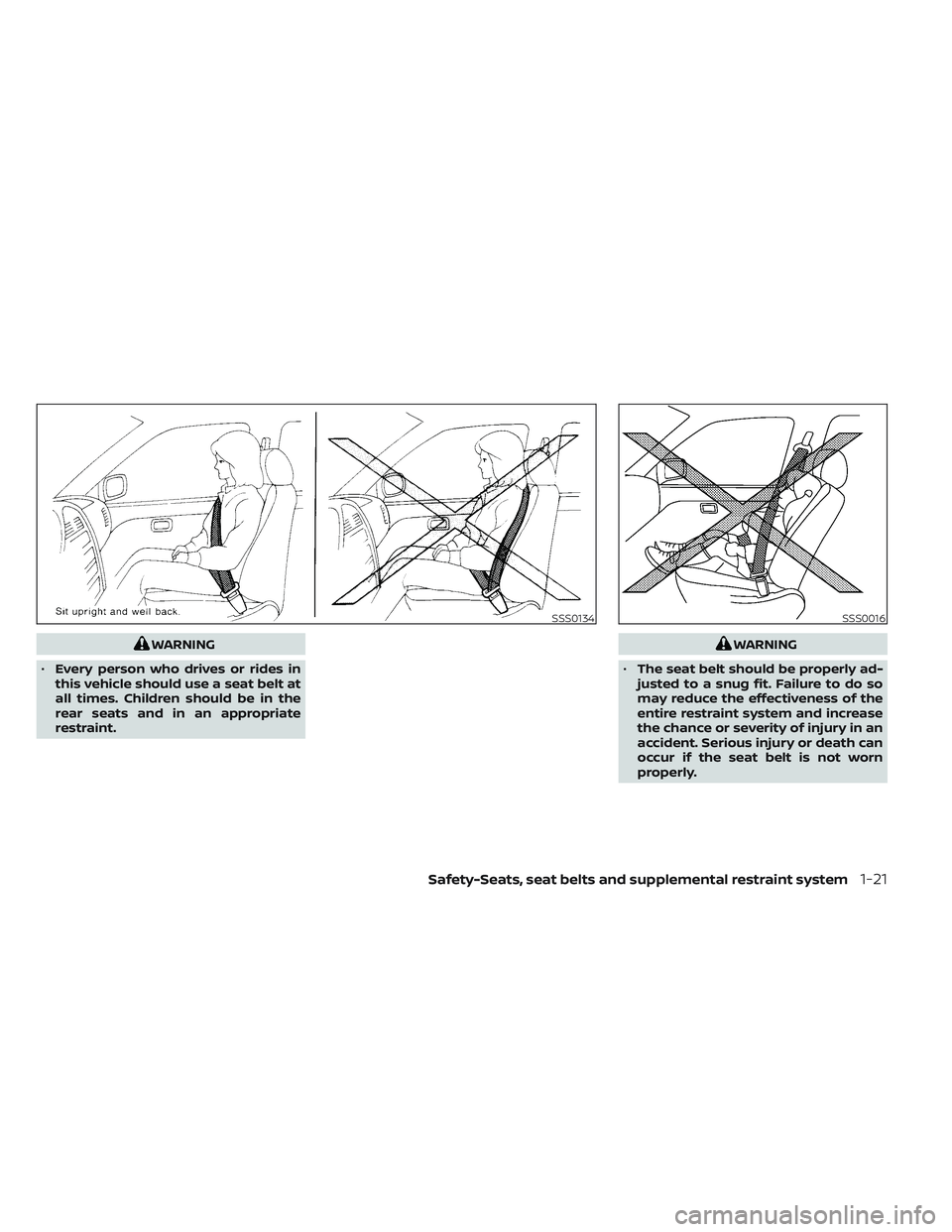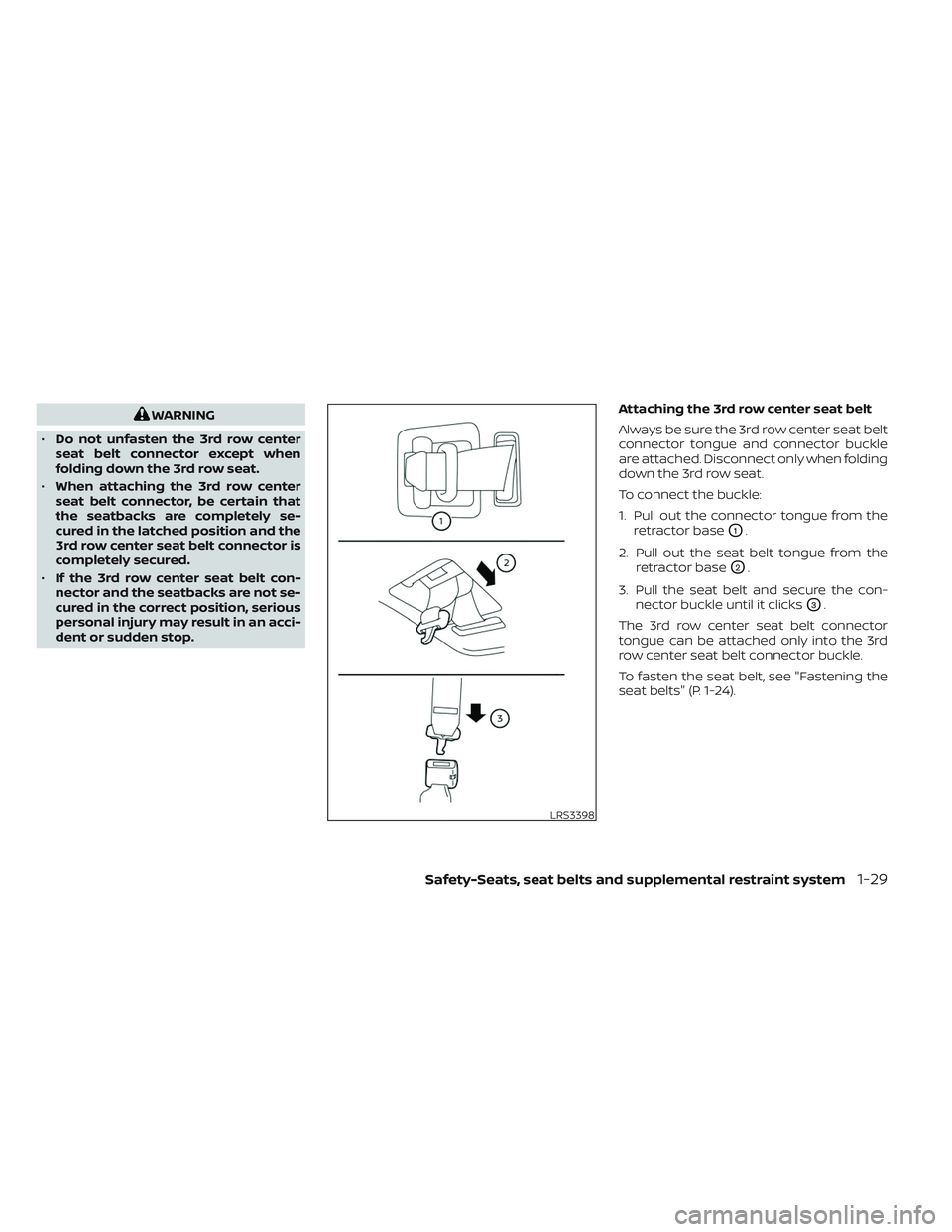2022 NISSAN PATHFINDER warning
[x] Cancel search: warningPage 35 of 647

Folding the 3rd row seats
To fold the 3rd row seats flat for maximum
cargo capacity:
1. Pull the strap
OAto release the head
restraint/headrest forward.
2. Stow the 3rd row seat belts in the seat belt hooks
ODfound on the sides of the
cargo area.
3. Pull up on the latch
OBlocated in the
upper corner of each seatback and
lower the seatback forward over the
seat base. To return the 3rd row seats to a seating
position:
1. Use the pull straps
OCto raise each seat-
back. Pull back until the seatback latches
into position. Make sure to properly
raise each seatback to an upright and
secured position.
2. Do not use the pull strap to return the head restraint/headrest to the upright
position. Pull back on the head restraint/
headrest until it latches in the upright
position.
WARNING
When the seat is returned to the normal
seating position, the head restraints/
headrests must be returned to the up-
right position to properly protect ve-
hicle occupants.
CAUTION
• When folding the 2nd row seat for
maximum cargo holding, be sure
that the console does not contact the
center console of the captain’s seat
(if so equipped) to avoid possible
damage to the console.
WARNING
Head restraints/headrests supplement
the other vehicle safety systems. They
may provide additional protection
against injury in certain rear end colli-
sions. Adjustable head restraints/
headrests must be adjusted properly,
as specified in this section. Check the
adjustment af ter someone else uses
the seat. Do not attach anything to the
head restraint/headrest stalk, except
for Genuine NISSAN accessories spe-
cifically tested for use with the vehicle’s
head restraint/headrest stalk. Do not
remove the head restraint/headrest.
Do not use the seat if the head
restraint/headrest has been removed.
If the head restraint/headrest was re-
moved, reinstall and properly adjust
the head restraint/headrest before an
occupant uses the seating position.
Failure to follow these instructions can
reduce the effectiveness of the head
restraints/headrests. This may in-
crease the risk of serious injury or
death in a collision.
LRS3359
HEAD RESTRAINTS/HEADRESTS
1-12Safety-Seats, seat belts and supplemental restraint system
Page 42 of 647

FOLDING HEAD
RESTRAINT/HEADREST
To fold the head restraint/headrest, pull the
strap located on the rear of the head
restraint/headrest.
If the head restraint/headrest has been
folded, make sure that it is returned to the
upright position.
Make sure the head restraint/headrest is
positioned so the lock knobs are engaged
in the notches before riding in that desig-
nated seating position.
WARNING
When the seat is returned to the normal
seating position, the head restraint/
headrest must be returned to the up-
right position to properly protect ve-
hicle occupants.
LRS2307
Safety-Seats, seat belts and supplemental restraint system1-19
Page 44 of 647

WARNING
• Every person who drives or rides in
this vehicle should use a seat belt at
all times. Children should be in the
rear seats and in an appropriate
restraint.WARNING
• The seat belt should be properly ad-
justed to a snug fit. Failure to do so
may reduce the effectiveness of the
entire restraint system and increase
the chance or severity of injury in an
accident. Serious injury or death can
occur if the seat belt is not worn
properly.
SSS0134SSS0016
Safety-Seats, seat belts and supplemental restraint system1-21
Page 45 of 647

WARNING
• Always route the shoulder belt over
your shoulder and across your chest.
Never put the belt behind your back,
under your arm or across your neck.
The belt should be away from your
face and neck, but not falling off your
shoulder.
• Position the lap belt as low and snug
as possible AROUND THE HIPS, NOT
THE WAIST. A lap belt worn too high
could increase the risk of internal in-
juries in an accident. •
Be sure the seat belt tongue is se-
curely fastened to the proper buckle.
• Do not wear the seat belt inside out
or twisted. Doing so may reduce its
effectiveness.
• Do not allow more than one person
to use the same seat belt.
• Never carry more people in the ve-
hicle than there are seat belts.
• If the seat belt warning light glows
continuously or chime continues
while the ignition is turned ON with
all doors closed and all seat belts fas-
tened, it may indicate a malfunction
in the system. Have the system
checked. It is recommended that you
visit a NISSAN dealer for this service.
• No changes should be made to the
seat belt system. For example, do not
modif y the seat belt, add material, or
install devices that may change the
seat belt routing or tension. Doing so
may affect the operation of the seat
belt system. Modif ying or tampering
with the seat belt system may result
in serious personal injury. •
Once seat belt pretensioner(s) have
activated, they cannot be reused and
must be replaced together with the
retractor. It is recommended that you
visit a NISSAN dealer for this service.
• All seat belt assemblies, including re-
tractors and attaching hardware,
should be inspected af ter any colli-
sion. It is recommended that you visit
a NISSAN dealer for this service.
NISSAN recommends that all seat
belt assemblies in use during a colli-
sion be replaced unless the collision
was minor and the belts show no
damage and continue to operate
properly. Seat belt assemblies not in
use during a collision should also be
inspected and replaced if either
damage or improper operation is
noted.
• All child restraints and attaching
hardware should be inspected af ter
any collision. Always follow the re-
straint manufacturer's inspection in-
structions and replacement recom-
mendations. The child restraints
should be replaced if they are
damaged.
SSS0014
1-22Safety-Seats, seat belts and supplemental restraint system
Page 46 of 647

SEAT BELT WARNING LIGHT AND
CHIME
Both the driver's and passenger's front
seats are equipped with a seat belt warn-
ing light. The warning light, located on the
instrument panel, will show the status of
the driver and passenger seat belt.
NOTE:
The front passenger seat belt warning
light will not light up if the seat is not
occupied.For additional information, see “Warning
lights, indicator lights and audible remind-
ers” (P. 2-12).
PREGNANT WOMEN
NISSAN recommends that pregnant
women use seat belts. The seat belt should
be worn snug and always position the lap
belt as low as possible around the hips, not
the waist. Place the shoulder belt over your
shoulder and across your chest. Never run
the lap/shoulder belt over your abdominal
area. Contact your doctor for specific
recommendations.
INJURED PERSONS
NISSAN recommends that injured persons
use seat belts. Check with your doctor for
specific recommendations.
THREE-POINT TYPE SEAT BELT
WITH RETRACTOR
WARNING
• Every person who drives or rides in
this vehicle should use a seat belt at
all times. Children should be in the
rear seats and in an appropriate
restraint.
• Do not ride in a moving vehicle when
the seatback is reclined. This can be
dangerous. The shoulder belt will not
be against your body. In an accident,
you could be thrown into it and re-
ceive neck or other serious injuries.
You could also slide under the lap belt
and receive serious internal injuries.
• For the most effective protection
when the vehicle is in motion, the
seat should be upright. Always sit
well back and upright in the seat with
both feet on the floor and adjust the
seat belt properly.
LRS0786
Safety-Seats, seat belts and supplemental restraint system1-23
Page 49 of 647

3. Position the lap belt portionlow and
snug on the hips
OBas shown.
4. Pull the shoulder belt portion toward the retractor to take up extra slack
OC.Be
sure the shoulder belt is routed over
your shoulder and across your chest.
The front passenger seat and the rear
seating positions’ three-point seat belts
have two modes of operation:
• Emergency Locking Retractor (ELR)
• Automatic Locking Retractor (ALR) The ELR mode allows the seat belt to ex-
tend and retract to allow the driver and
passengers some freedom of movement
in the seat. The ELR locks the seat belt
when the vehicle slows down rapidly or
during certain impacts.
The ALR mode (child restraint mode) locks
the seat belt for child restraint installation.
When the ALR mode is activated, the seat
belt cannot be extended again until the
seat belt tongue is detached from the
buckle and fully retracted. The seat belt re-
turns to the ELR mode af ter the seat belt
fully retracts. For additional information,
see “Child restraints” (P. 1-34).
The ALR mode should be used only for
child restraint installation. During nor-
mal seat belt use by an occupant, the ALR
mode should not be activated. If it is ac-
tivated, it may cause uncomfortable seat
belt tension. It can also change the op-
eration of the front passenger air bag.
For additional information, see “Front
passenger air bag and status light”
(P. 1-71).
WARNING
When fastening the seat belts, be cer-
tain that the seatbacks are completely
secured in the latched position. If they
are not completely secured, passen-
gers may be injured in an accident or
sudden stop.
LRS2675
1-26Safety-Seats, seat belts and supplemental restraint system
Page 51 of 647

WARNING
• Always fasten the connector tongue
and the seat belt in the order shown.
• Always make sure both the connec-
tor tongue and the seat belt tongue
are secured when using the seat belt
or installing a child restraint. Do not
use the seat belt or child restraint
with only the seat belt tongue at-
tached. This could result in serious
personal injury in case of an accident
or a sudden stop. Stowing the 3rd row center seat belt
When folding down the 3rd row seat, the
center seat belt can be retracted into a
stowed position as follows:
1. Hold the connector tongue
O1so that
the seat belt does not retract suddenly
when the tongue is released from the
connector buckle. Release the connec-
tor tongue by inserting a suitable tool
such as a key
OAinto the connector
buckle.
2. Insert the seat belt tongue into the re- tractor base first
O2by inserting the seat
belt tongue into the uppermost hole of
the retractor base.
3. Then secure the connector tongue into the retractor base
O3by inserting the
connector tongue to the lower hole of
the retractor base and pushing it into
the clip.
SSS0241
LRS3397
1-28Safety-Seats, seat belts and supplemental restraint system
Page 52 of 647

WARNING
• Do not unfasten the 3rd row center
seat belt connector except when
folding down the 3rd row seat.
• When attaching the 3rd row center
seat belt connector, be certain that
the seatbacks are completely se-
cured in the latched position and the
3rd row center seat belt connector is
completely secured.
• If the 3rd row center seat belt con-
nector and the seatbacks are not se-
cured in the correct position, serious
personal injury may result in an acci-
dent or sudden stop. Attaching the 3rd row center seat belt
Always be sure the 3rd row center seat belt
connector tongue and connector buckle
are attached. Disconnect only when folding
down the 3rd row seat.
To connect the buckle:
1. Pull out the connector tongue from the
retractor base
O1.
2. Pull out the seat belt tongue from the retractor base
O2.
3. Pull the seat belt and secure the con- nector buckle until it clicks
O3.
The 3rd row center seat belt connector
tongue can be attached only into the 3rd
row center seat belt connector buckle.
To fasten the seat belt, see "Fastening the
seat belts" (P. 1-24).
LRS3398
Safety-Seats, seat belts and supplemental restraint system1-29